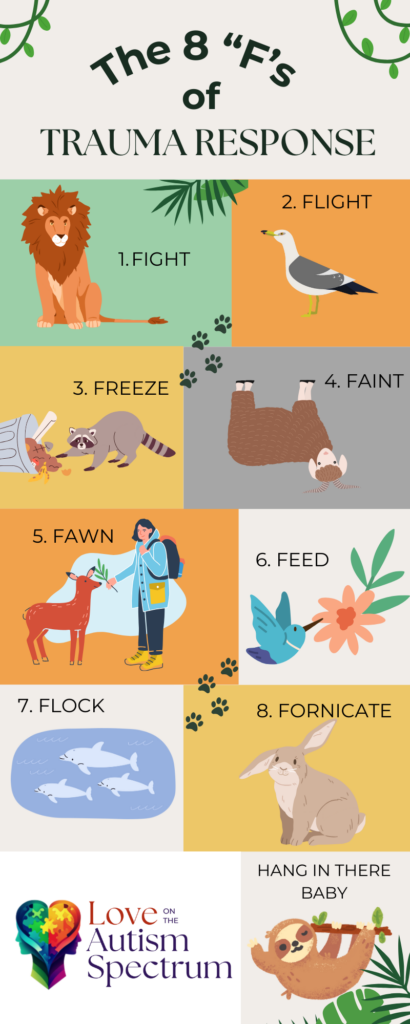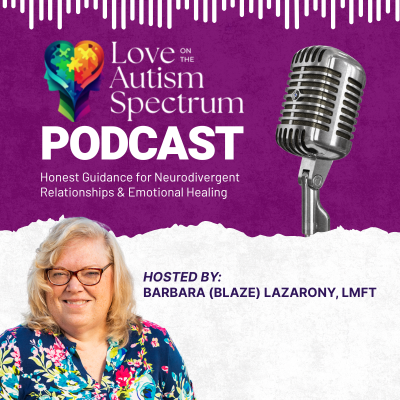In this blog post, we will attempt to go beyond flight, fight, and freeze and explore all eight “F” words commonly used to describe reactions to trauma and how understanding them can help you heal and recover.
Key Takeaways:
- Trauma survivors experience a range of physical and emotional symptoms in response to trauma.
- Learn the brain and body connection from traumatic stress.
- Learning about the eight “F” words can help you better understand your body’s response to a traumatic event and manage your symptoms.
What is Trauma and a Trauma Response?
Trauma is a physical and emotional response to a distressing event. One-time events, such as car accidents or natural disasters, or chronic stressors, such as abuse or neglect, can cause it. Trauma may have short-term and long-term effects on your physical and mental health.
The good news is that there are things you can do to understand your brain and your body better.
The Brain and Body are Working Together
When the human body senses danger or stressful situations, it triggers an alarm system that consists of three parts: the autonomic nervous system (ANS), the Sympathetic Nervous System (SNS), and the Parasympathetic Nervous System (PNS).
The SNS has been called “the most powerful survival tool” because it gives you extra energy when needed for a quick response. This means focusing on “fight-or-flight” mode without overthinking what might happen after you get out alive.
The Sympathetic Nervous System is a part of our brain designed to react in emergencies. It causes the body to release adrenaline and cortisol, which increases heart rate while also widening the muscles around your eyes so you can see better if there are threats nearby or run away from danger quickly enough! The part of the brain responsible for regulating heart rate and fear plays a crucial role in the trauma response, ensuring our survival during threatening situations.
This SNS alarm system is designed to help us survive. It’s like an invisible shield that pops up when we need it the most. For example, if you were about to walk in front of a moving car, your body would automatically tense up, your heart rate would increase, and you would probably start to sweat. These are all physical reactions that happen to help you get out of danger quickly.
The Parasympathetic Nervous System is activated when we are at risk for an injury or need some time off. It slows down heart rate, blood pressure, and respiration. This response is designed to help us stay calm, rest, and digest. So, when the threat has passed and we are no longer in danger, our body can relax and return to its normal state.
The stress response is a normal and natural way for the body to protect itself. After the danger has passed, the body should return to its normal state.
The SNS and PNS work together to balance our body’s response to stress. While the SNS prepares us for action, the PNS helps us recover and restore our equilibrium. Without this balance between both systems, we could not effectively respond to threats or recover from them.
In addition to physical responses, these two systems also affect emotional regulation. The SNS triggers emotions such as fear and anxiety, while the PNS helps regulate these emotions and promotes feelings of calmness and relaxation.
The Reactions to Trauma and Perceived Threat Start in the Limbic System
The brain is the control center of the body. It is responsible for everything from thinking and feeling to moving and breathing. The brain controls the nervous system, which controls the rest of the body.
The limbic system within the brain is responsible for the traumatic response and comprises several structures, including the hippocampus, amygdala, and thalamus.
The hippocampus is responsible for learning and memory; it’s the part of the brain that stores information about what happened during the trauma. Think of it as a timeline of emotions; however, it can’t determine if the trauma behavior happened in the past or right now.
The amygdala is responsible for fear and anxiety. The part of the brain makes you feel scared or anxious when you are in the Trauma Response, a primitive survival response that happens when you feel threatened. It is an automatic, unconscious reaction that happens in the brain before we even have a chance to think about what is happening.
The thalamus is responsible for sending information to the rest of the brain. It acts like a switchboard, sending messages to different brain parts.
These three structures are essential for our survival. They help us respond to harmful or threatening situations. The Limbic system is also the oldest part of the brain, and it is sometimes called the “reptilian brain” because it is similar to the simple brains of reptiles.
Understanding the complexity of the human brain in processing threats reveals that it’s too simplistic to say our trauma responses are merely fight-or-flight. The human brain exhibits eight trauma responses, highlighting its intricate role in navigating and processing traumatic events. This complexity underscores the brain’s sophisticated mechanisms for ensuring our survival and adapting to perceived dangers.
The Limbic system is our most primitive rule follower; it believes that what happened in the past will happen again. This is why people who have suffered from Post-Traumatic Stress Disorder (PTSD) often feel like they are in danger even when in reality they are not. The Limbic system tries to protect us from harm, but it can sometimes go too far, and it can override normal physical and emotional reactions.
What Does a Trauma Response Feel Like?
The physical symptoms of a trauma response can vary from person to person. Some people might feel like they are going to faint or vomit. Others might have a pounding heart, trouble breathing, or feel like they are choking. Some people might feel outside their bodies or detached from what is happening around them. Other people want to sleep for a very long time.
You may hear the phrase, “It feels like the trauma button got stuck on,” or they “got triggered,” that’s what so many people who suffer from posttraumatic stress disorder (PTSD) tend to say when they don’t know if the trauma is in the past or present.
The emotional symptoms of the Trauma Response can also vary. Some people might feel scared, hopeless, or helpless, while others might feel angry, guilty, or ashamed. Traumatic stress can also lead to a sense of numbness or emptiness, as well as difficulty experiencing positive emotions. Developing emotional regulation skills is crucial in managing these trauma responses effectively.
These symptoms are not just limited to those who have experienced trauma firsthand. Family members and loved ones of those who have been through traumatic events can also experience similar emotional distress and guilt. This is known as secondary traumatization or vicarious traumatization.
Remember, the goal of the trauma response is to help us survive. Traumatic experiences are not designed to make us feel good. (Oh, how I wish this were different!) Additionally, understanding how the body’s reaction to a perceived threat can trigger various trauma responses is essential for comprehending the complexity of trauma.
What happens in our Brain when Traumatic Stress Occurs?
When we experience trauma, our brains go into survival mode, triggering the release of stress hormones like adrenaline and cortisol. These stress hormones are part of the body’s internal cocktail that gets amped up from trauma and every trigger thereafter, preparing us to fight, flee, fight flight freeze, and even five more “F” responses.
It’s also important to share that the brain is plastic, which means it can change. With treatment, trauma survivors can learn to control their response to trauma, addressing the altered physiology and developing skills for relaxation and regulation, thereby improving their quality of life.
Let’s dive into the story of each of the eight F’s, and I invite you to try to answer the question, What does your body do in the face of danger to feel safe?
Understanding Trauma Responses: The 8 “F” words of Fight or Flight
1. Fight:
The first F is Fight. This is one of the most well-known body responses to Trauma. When you are faced with trauma, your body’s natural response may be to fight. This means you will feel a surge of energy and adrenaline; your body tells you you must take action immediately.

If the Fight trauma response is one of your primary responses, your body is poised to be physically or verbally aggressive. You might feel like you can’t sit still or need to scream or yell; you may even find yourself grinding your teeth or having a stomach ache. Your heart rate and breathing will increase, and you might shake or sweat.
For some people, their Fight trauma response looks like posting rants on social media or spreading rumors about someone whom they feel has done them wrong. Common reactions to the fight response include anger, aggression, and impulsivity.
It’s important to understand that the Fight response is a natural and instinctive reaction to perceived danger or threat. Physical and emotional stressors can trigger it and be a protective mechanism in certain situations. However, when this response is constantly activated in everyday situations, it can become harmful and lead to destructive behaviors.
Suppose your body’s natural first reaction to trauma is the fight response. In that case, you may associate the animal metaphor of an angry lion with the loudest and biggest roar heard in the jungle, asserting its power over danger.
2. Flight:
The second F is Flight. This is another well-known body response to Trauma. When you are faced with Trauma, your body’s natural response is to try to get away from the situation, run, flee, or leave. You might feel like you need to run away or hide. Your heart rate and breathing will increase, and you might shake or sweat; many people also report pain or heat in their thighs because of a natural predisposition just to run.
For some people, their Flight response looks like trying to avoid the person or situation that caused them Trauma. Physical and emotional safety is the main priority; sometimes, that means physically removing yourself from the danger or avoiding it altogether. However, constantly running away can be exhausting and may not always be a viable solution. Individuals with ADHD may exhibit flight responses by withdrawing from social situations, avoiding responsibilities, or seeking distractions as a way to cope with overwhelming emotions or to avoid triggering anxiety or stress.
While Flight can initially provide relief and a sense of safety, it is essential to recognize when this response becomes unhealthy and prevents healing from the Trauma. Finding healthy coping mechanisms and addressing the root cause of the Trauma are crucial steps in moving toward healing and recovery.
Suppose Flight is your body’s first natural response to Trauma. In that case, you may associate it with the animal metaphor of a seagull, known for its ability to fly away from danger quickly.
3. Freeze:
The third F is Freeze. When you face trauma, your body’s natural response may be to Freeze. This means you will feel like you can’t move or speak; you might feel like you’re in slow motion or that time has stopped. Your heart rate and breathing will decrease, and you might shake or sweat. You may also feel cold or nauseous and left feeling numb or dissociated.
Their freeze response looks like feeling paralyzed or frozen in place for some people. They might be unable to leave the house or get out of bed. They might have difficulty talking about the Trauma or even thinking about it. Fear can also look like disconnecting from your body by using drugs or alcohol to numb out. Some people who are in recovery programs share that Freeze is their go-to trauma response.
If Freeze is your body’s first natural response to Trauma, you may associate it with the animal metaphor of a small raccoon caught in the headlights of an oncoming car; it is scared and frozen in place, not knowing what to do as it stares back at you.
4. Faint:
The fourth F is Faint. When you face trauma, your body’s natural response may be to Faint. This means that you will feel like you will pass out or lose consciousness, and your heart rate and breathing will decrease.
For some people, a Faint response involves feeling lightheaded or dizzy, having a hard time standing up, or feeling like they will vomit. People also report that sleeping long after the danger has passed is another form of Faint.
In childhood, many of us associate with the faint response because we realize we are not tall enough to run away or fight, so we try to make ourselves as small as possible and hope that the danger will go away if we close our eyes and sleep. (Many times, parents even encourage this way of coping with the fear of the trauma response with children by inviting them to just go to sleep.)
If Faint is your body’s first natural response to Trauma, you may associate it with the metaphor of a goat, an animal that plays dead when it feels threatened.
5. Fawn:
The fifth F is Fawn. When you face trauma, your body’s natural response may be to Fawn. This means that you will feel like you need to please the person causing you Trauma or making you uncomfortable, often engaging in behaviors aimed at pleasing others to avoid conflict or further trauma.
For some people, their Fawn response looks like they need to do whatever the other person wants. They might agree to things they don’t want to do or try to make the other person happy, even if it personally makes them unhappy. People who Fawn often feel like they are not in control of their lives.
The fawn process encourages you to suppress your feelings and try to make everyone else happy instead of yourself. You might even say yes when you mean no because you don’t want to upset the other person or cause them any inconvenience. Does this sound like you?
If Fawn is your body’s first natural response to Trauma, you may associate it with the animal metaphor of a deer caught in the headlights, as it feels like it needs to do whatever the other person wants.
6. Feed:
The sixth F is Feed. When you face trauma, your body’s natural response may be to Feed. This means you will feel like you need to respond to the danger by eating or drinking something.
For some people, their Feed response looks like feeling like they need to eat all the time or they are constantly hungry. They might also feel like they need to drink alcohol or even use drugs. People who are challenged with posttraumatic stress disorder (PTSD) may also find themselves using food or substances to cope with their own emotions and trauma.
On the other hand, some people may have a different reaction to Feed when facing trauma. Instead of feeling like they need to eat, they might lose their appetite and lack interest in food. This can be especially concerning if it becomes a long-term issue and leads to weight loss and malnutrition.
Regardless of how your body’s Feed response manifests itself, it’s essential to recognize that it is a common coping mechanism for dealing with trauma. However, relying on food or substances as a way to cope with grief can be harmful in the long run and may lead to additional health problems, such as eating disorders.
People who are also prone to cutting or other forms of self-harm may use this Trauma response to fill an emptiness within themselves.
Suppose Feed is your body’s first natural response to Trauma. In that case, you may associate it with the animal metaphor of a hummingbird, constantly searching the blossoms for nectar and something delicious to eat and enjoy.
7. Flock:
The seventh F is Flock. This is another response that is not as well-known as Fight or Flight, but it is just as expected. When you face trauma, your body’s natural response may be to Flock. This means you will feel like you need to be around others.
For some people, their Flock response involves feeling like they need to be around other people all the time. They might go to parties or clubs even when they don’t want to or spend time on social media. People who Flock often use other people to avoid dealing with their Trauma.
Trauma symptoms for flockers include:
– Feeling anxious or uncomfortable when alone
– Constantly seeking out social interactions to fill a void
– Difficulty setting boundaries with others
– Using relationships as a distraction from trauma
If Flock is your body’s first natural response to Trauma, you may associate it with the animal metaphor of a pod of dolphins, as they stay close to each other for safety.
8. Fornicate:
The eighth and final F is Fornicate. When you face trauma, your body’s natural response may be to Fornicate. This means that you will feel like you need to have sex or be sexual with someone. You may be prone to engage in high-risk sexual behaviors or seek out several different partners to respond to trauma danger.
For some people, their Fornicate response can also include a pornography addiction or excessive flirting. People who favor a Fornicate response may indulge themselves in instant gratification, typically resulting in further suppression of their healthy emotions.
If Fornicate is your body’s natural response to Trauma, you may associate it with the animal metaphor of rabbits; they have a high desire to have sex and also a high reproduction rate. Don’t forget that rabbits are a symbol of fertility and new beginnings.
Were You able to Identify your Unique Trauma Responses?
- Now that you know the eight F’s of Trauma Response, can you identify which one is your primary response?
- Do you have more than one Trauma Response?
- How do you think knowing your Trauma Response will help your healing journey?
Now that you know more about Trauma Response, you can begin to work on managing your common reactions and symptoms and start living a fuller life.
Remember, you are not alone in this journey; don’t hesitate to contact me for professional therapy, counseling, writing, and coaching help!
Summary
Recovery from trauma is a unique and individual process, and everyone’s healing journey will be different. Understanding your Trauma Response can better manage your symptoms and improve your overall quality of life.
Don’t forget that many resources are available to help you on your path to recovery. Reach out for professional help if needed; remember, you are not alone. Keep working towards a healthier and happier future, one step at a time.
So, continue to learn more about your Trauma Response and take steps towards healing. Remember that it is never too late to begin your journey of recovery from trauma. No matter how difficult it may seem, there is always hope for a better tomorrow.
Frequently Asked Questions
Are there any self-care practices that can help manage Trauma Responses?
Yes, self-care practices such as exercise, mindfulness techniques, and healthy coping mechanisms like journaling or talking to a trusted friend or therapist can help manage Trauma Responses. Services like therapy, support groups, phone apps, and medication can also be beneficial.
Can I manage my Trauma Response without professional help?
While self-help techniques and coping strategies can be helpful, seeking mental health support is often recommended for managing Trauma Responses. A therapist or counselor can provide specialized guidance in your healing journey.
Dissociation and flashbacks are common trauma responses where individuals may feel disconnected from their thoughts, feelings, memories, or surroundings, or they are replaying the situation in their mind. It’s essential to seek support from a mental health professional if you experience dissociative or flashback symptoms.
How long does it take to recover from trauma?
The recovery process from trauma varies for each individual, and there is no specific timeline. It can depend on the severity of the trauma, personal resilience, and access to support and treatment. It’s essential to be patient with yourself and trust your healing process.
As a side note, childhood trauma can have a lasting impact on an individual’s response to trauma. It can lead to difficulty regulating emotions, forming healthy relationships, and managing stress. Understanding how childhood trauma may influence your reactions to traumatic events can help develop appropriate coping strategies.
Can I still experience Trauma Responses even if my traumatic event happened a long time ago?
Yes, past traumatic events can resurface at any point in life, particularly during stress or triggers. It’s essential to continue practicing self-care and seeking support, even after the initial trauma.
It makes sense to recognize and address any Trauma Responses that may arise to promote healing and well-being. Talk to a therapist or counselor if you feel overwhelmed by past events. If you are in immediate danger, don’t hesitate to reach out to 988, the National Suicide and Crisis Lifeline.
How can I support a loved one dealing with Trauma Responses?
If you know someone who has experienced trauma, it is essential to educate yourself about Trauma Responses.
By understanding their experience, you can provide support and validation without judgment. Listening, offering reassurance, and encouraging them to seek professional help are all essential ways to support a loved one dealing with Trauma Responses.
Remember to take care of your well-being while supporting someone going through a challenging time.







